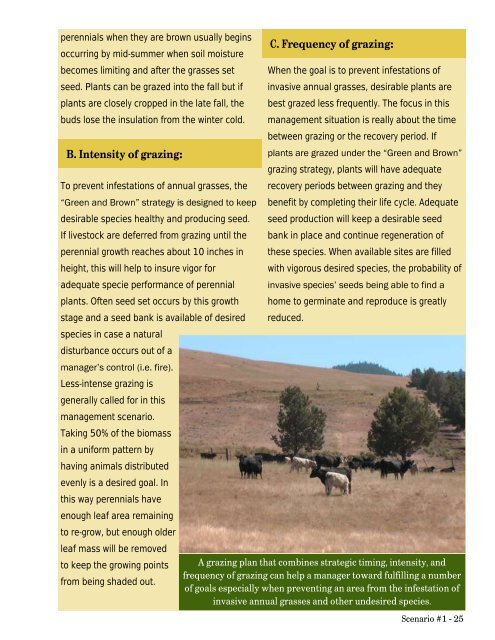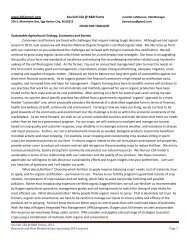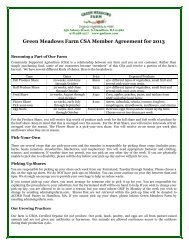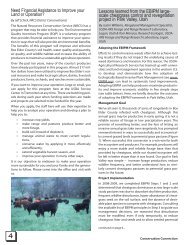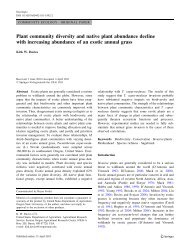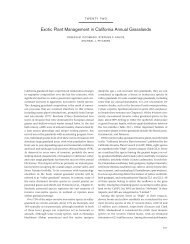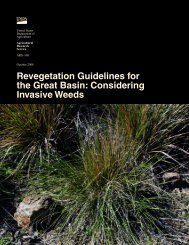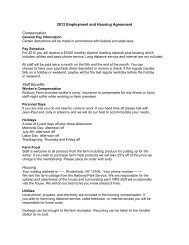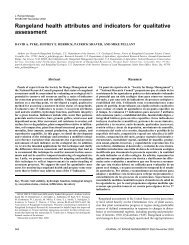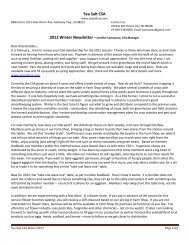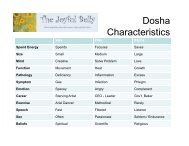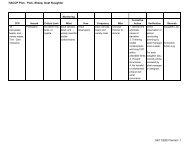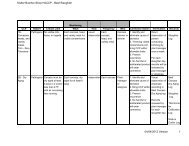“Green and Brown” Grazing Strategy
“Green and Brown” Grazing Strategy
“Green and Brown” Grazing Strategy
You also want an ePaper? Increase the reach of your titles
YUMPU automatically turns print PDFs into web optimized ePapers that Google loves.
perennials when they are brown usually begins<br />
occurring by mid-summer when soil moisture<br />
becomes limiting <strong>and</strong> after the grasses set<br />
seed. Plants can be grazed into the fall but if<br />
plants are closely cropped in the late fall, the<br />
buds lose the insulation from the winter cold.<br />
B. Intensity of grazing:<br />
To prevent infestations of annual grasses, the<br />
<strong>“Green</strong> <strong>and</strong> <strong>Brown”</strong> strategy is designed to keep<br />
desirable species healthy <strong>and</strong> producing seed.<br />
If livestock are deferred from grazing until the<br />
perennial growth reaches about 10 inches in<br />
height, this will help to insure vigor for<br />
adequate specie performance of perennial<br />
plants. Often seed set occurs by this growth<br />
stage <strong>and</strong> a seed bank is available of desired<br />
species in case a natural<br />
disturbance occurs out of a<br />
manager’s control (i.e. fire).<br />
Less-intense grazing is<br />
generally called for in this<br />
management scenario.<br />
Taking 50% of the biomass<br />
in a uniform pattern by<br />
having animals distributed<br />
evenly is a desired goal. In<br />
this way perennials have<br />
enough leaf area remaining<br />
to re-grow, but enough older<br />
leaf mass will be removed<br />
to keep the growing points<br />
from being shaded out.<br />
C. Frequency of grazing:<br />
When the goal is to prevent infestations of<br />
invasive annual grasses, desirable plants are<br />
best grazed less frequently. The focus in this<br />
management situation is really about the time<br />
between grazing or the recovery period. If<br />
plants are grazed under the <strong>“Green</strong> <strong>and</strong> <strong>Brown”</strong><br />
grazing strategy, plants will have adequate<br />
recovery periods between grazing <strong>and</strong> they<br />
benefit by completing their life cycle. Adequate<br />
seed production will keep a desirable seed<br />
bank in place <strong>and</strong> continue regeneration of<br />
these species. When available sites are filled<br />
with vigorous desired species, the probability of<br />
invasive species’ seeds being able to find a<br />
home to germinate <strong>and</strong> reproduce is greatly<br />
reduced.<br />
A grazing plan that combines strategic timing, intensity, <strong>and</strong><br />
frequency of grazing can help a manager toward fulfilling a number<br />
of goals especially when preventing an area from the infestation of<br />
invasive annual grasses <strong>and</strong> other undesired species.<br />
Scenario #1 - 25


